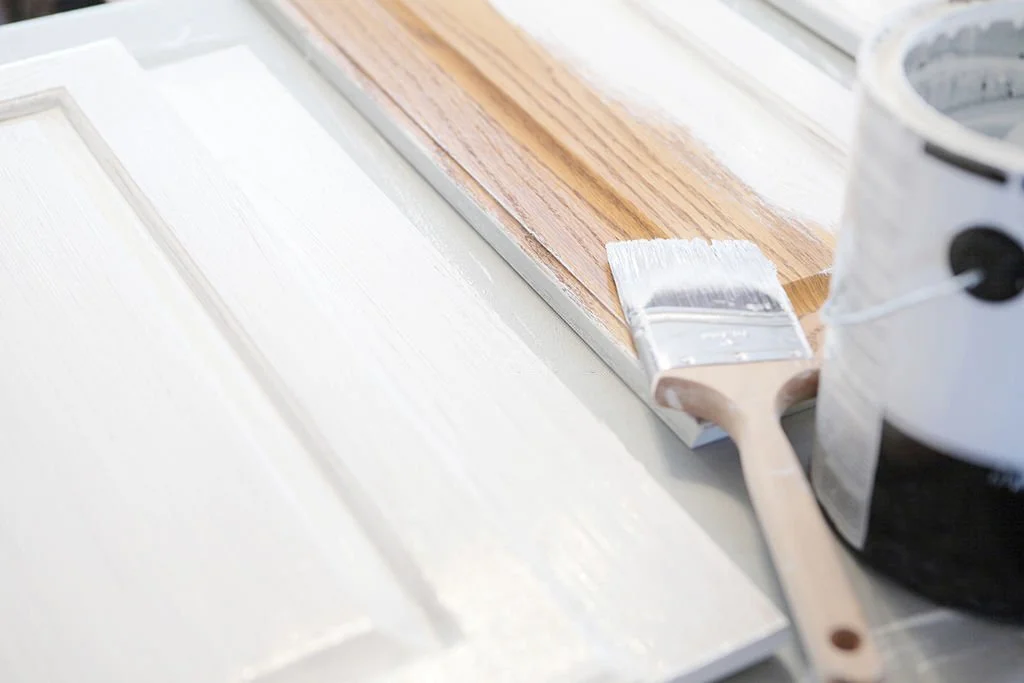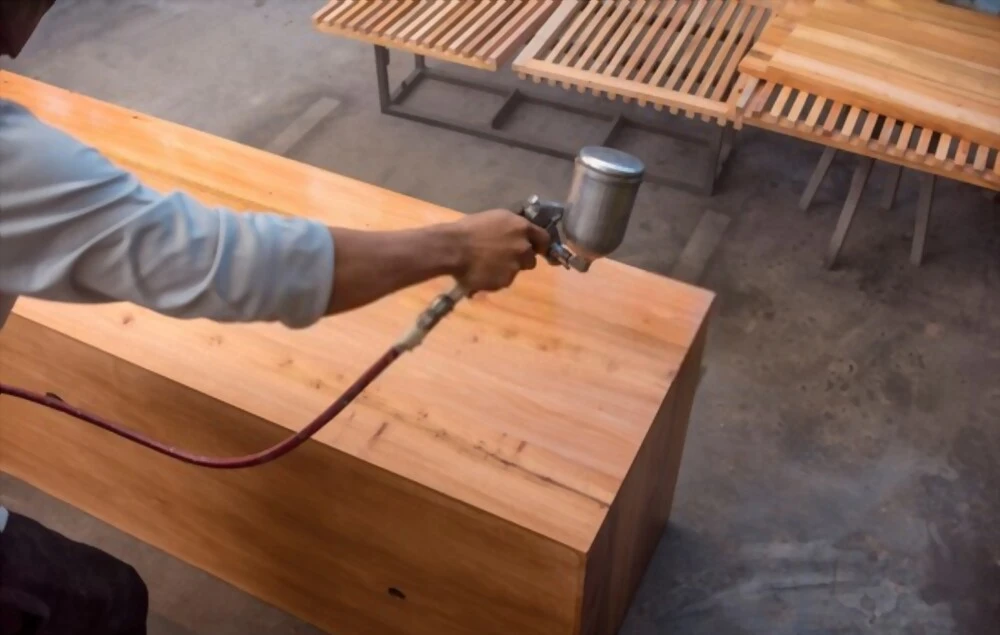
To keep painted cabinets from scratching, ensure proper surface preparation, use high-quality paint and sealant, clean and maintain them regularly, control humidity levels in your kitchen, utilize appropriate lighting, and choose the right cabinet hardware.
As a seasoned professional painter, I’ve seen countless homeowners fall in love with the fresh, clean look of painted cabinets. Unfortunately, I’ve also witnessed the heartbreak of scratched paint, marring the beautiful finish.
Fear not, friends! In this detailed guide, I’ll share insider tips on keeping your painted cabinets looking immaculate and scratch-free. So, let’s dive right in and discover how to keep painted cabinets from scratching.
- Proper Surface Preparation: The Foundation for Keeping Painted Cabinets from Scratching
- Choose High-Quality Paint: Your Cabinets’ Armor
- Protect Your Painted Cabinets with a Clear Coat
- Regular Cleaning and Maintenance
- Fixing Scratches on Painted Kitchen Cabinets
- Ensuring the Longevity of Your Painted Cabinets
- Maintaining Proper Humidity Levels
- The Role of Lighting in Preventing Scratches
- Choosing the Right Cabinet Hardware
- Conclusion
Proper Surface Preparation: The Foundation for Keeping Painted Cabinets from Scratching
Cleaning and Sanding
To achieve a scratch-resistant finish, start with a clean, rough surface. This ensures your paint adheres properly, creating a durable bond. Remove all grease, dirt, and grime using a gentle cleaning solution, such as a mixture of warm water and mild dish soap. Rinse thoroughly and allow the surface to dry.
Next, sand the cabinet surfaces using a medium-grit sandpaper (120-150 grit). This creates small grooves for the paint to grip onto, enhancing adhesion. Remember to sand in the direction of the wood grain to prevent cross-grain scratches. Wipe away sanding dust with a slightly damp microfiber cloth before moving on to the next step.
Primer Selection
A high-quality primer is essential for achieving a long-lasting, scratch-free finish. Primers not only provide a smooth surface for paint application but also strengthen the bond between paint and cabinet material.
For most cabinet surfaces, a stain-blocking primer works wonders. However, if you’re working with laminate or melamine cabinets, opt for a bonding primer. This type of primer is specifically designed for surfaces with less paint adhesion. Be sure to apply the primer evenly and allow it to dry completely before moving on to the paint application.
Choose High-Quality Paint: Your Cabinets’ Armor
Paint Types
When it comes to protecting your cabinets from scratches, not all paints are created equal. Low-VOC alkyd enamel paint is a top choice among professional painters for its durability and ease of use. This type of paint provides a hard, glossy finish that stands up well to daily wear and tear.
Other excellent options for painted cabinets include 100% acrylic latex paint and waterborne alkyd paint. These paints also offer excellent durability and are known for their resistance to chipping and scratching.
Application Techniques
The key to a beautiful, scratch-resistant finish lies in proper paint application. Start by applying thin, even coats of paint, allowing each layer to dry completely before applying the next. This helps prevent paint buildup and ensures a smooth, even finish.
When applying paint, use a high-quality brush or foam roller designed for smooth surfaces. Avoid using low-quality brushes, as they can leave behind bristle marks and may shed during application, compromising the final appearance of your cabinets.
Always remember to allow the paint to dry completely before reassembling your cabinets. This may take anywhere from 24 to 72 hours, depending on the paint type and environmental conditions.
Protect Your Painted Cabinets with a Clear Coat
The Benefits of a Clear Coat
A clear coat serves as a protective barrier, shielding your cabinets from scratches, moisture, and other potential damage. Applying a clear coat not only increases the durability of your painted cabinets but also enhances their appearance, providing a glossy or satin finish, depending on your preference.
Choosing the Right Clear Coat
There are several types of clear coats available on the market, with the most popular being polyurethane and epoxy. When selecting a clear coat, consider the following factors:
- Compatibility: Ensure the clear coat is compatible with the type of paint you’ve used on your cabinets.
- Finish: Choose a clear coat with the desired level of glossiness or matte finish.
- Durability: Opt for a high-quality, durable clear coat that can withstand daily wear and tear.
Apply the clear coat in thin, even layers, allowing each coat to dry thoroughly before applying the next. This ensures a smooth, professional-looking finish that lasts for years to come.
Regular Cleaning and Maintenance
Daily and Weekly Cleaning
To maintain your cabinets’ pristine appearance and prevent scratches, establish a regular cleaning routine. Dust and vacuum the surface of your cabinets regularly to remove grit, dirt, and dust that could potentially scratch the paint. Keep a close eye on cabinets near food preparation areas, and promptly clean any spills, stains, or residue to prevent them from settling into the painted surface.
Cleaning Supplies and Techniques
When cleaning your painted cabinets, always use gentle cleaning supplies and methods to avoid scratching or damaging the surface. Follow these guidelines:
- Use a soft, lint-free cloth for dusting and wiping down your cabinets. Avoid using abrasive materials like steel wool or scouring pads.
- Dampen your cloth slightly or use a gentle cleanser to remove dirt and grime. Never use harsh chemicals like bleach, ammonia, or oven cleaner.
- When wiping wooden cabinets, follow the direction of the wood grain to prevent scratches from occurring.
Fixing Scratches on Painted Kitchen Cabinets
Assess the Damage
Accidents happen, and even with the utmost care, scratches may occur on your painted cabinets. When you notice a scratch, assess the damage to determine the appropriate course of action. For minor scratches, a simple touch-up may suffice, while deeper scratches may require more attention.
Touching Up Minor Scratches
For small, superficial scratches, follow these steps to restore your painted cabinets to their original glory:
- Clean the area: Use a gentle cleanser to remove any dirt or grime from the affected area.
- Lightly sand: If necessary, lightly sand the scratch using fine-grit sandpaper to smooth out any rough edges.
- Apply touch-up paint: Using a small brush or a cotton swab, carefully apply a small amount of matching paint to the scratch. Allow the paint to dry completely before assessing whether additional coats are needed.
Ensuring the Longevity of Your Painted Cabinets
The Importance of Quality Materials
To keep your painted cabinets looking their best, always opt for high-quality materials. Invest in a durable paint specifically designed for cabinets, and choose a reliable primer to ensure proper adhesion. Using quality materials not only helps prevent scratches but also extends the lifespan of your cabinets.
Consistent Care and Attention
The key to maintaining your painted cabinets is consistent care and attention. Stick to a regular cleaning routine, address spills and stains immediately, and keep an eye out for any scratches or damage. By staying proactive and attentive, you’ll be able to prevent most scratches and keep your painted cabinets looking fabulous for years to come.
Maintaining Proper Humidity Levels
Why Humidity Matters
Humidity levels can have a significant impact on the longevity of your painted cabinets. Excessive moisture can cause paint to peel or warp, while extremely dry conditions can lead to paint cracking or chipping. Striking the right balance in humidity levels can help prevent these issues and keep your cabinets looking great.
Tips for Controlling Humidity
To maintain the proper humidity levels in your kitchen, consider the following:
- Use a dehumidifier: If your kitchen tends to be overly humid, use a dehumidifier to help regulate moisture levels.
- Install a kitchen exhaust fan: Ensure proper ventilation by installing a kitchen exhaust fan to remove excess moisture generated during cooking.
- Check for water leaks: Regularly inspect your plumbing and appliances for any leaks that could contribute to high humidity levels.
The Role of Lighting in Preventing Scratches
Natural Light and Paint Durability
Natural light can play a role in the durability of your painted cabinets. Prolonged exposure to direct sunlight can cause paint to fade or become brittle, increasing the risk of scratches. To prevent this, consider installing window coverings or using UV-resistant paint.
Effective Task Lighting
Having proper task lighting in your kitchen can reduce the risk of accidentally scratching your cabinets while preparing meals or cleaning. Ensure that your countertops and work areas are well-lit to minimize the chances of accidental damage.
Choosing the Right Cabinet Hardware
The Impact of Hardware on Cabinet Durability
Cabinet hardware can play a significant role in preventing scratches on your painted cabinets. The right hardware not only enhances the functionality of your cabinets but also helps protect their surfaces from wear and tear.
Selecting Appropriate Hardware
When choosing hardware for your painted cabinets, consider the following:
- Opt for soft-close hinges: These hinges help prevent doors from slamming shut, reducing the risk of scratches and dents.
- Install door bumpers: Adding door bumpers to your cabinet doors can help cushion the impact when they close, further protecting your painted surfaces.
- Choose handles and pulls wisely: Select hardware that is comfortable to use and complements your cabinets’ design. Quality handles and pulls can reduce the likelihood of accidental scratches during everyday use.
Conclusion
In conclusion, knowing how to keep painted cabinets from scratching is essential for maintaining their beauty and longevity. By following the tips outlined in this guide, including proper surface preparation, using the right paint and sealant, regular cleaning and maintenance, controlling humidity levels, implementing appropriate lighting, and selecting the right hardware, you can ensure that your painted cabinets remain scratch-free and looking their best for years to come.



